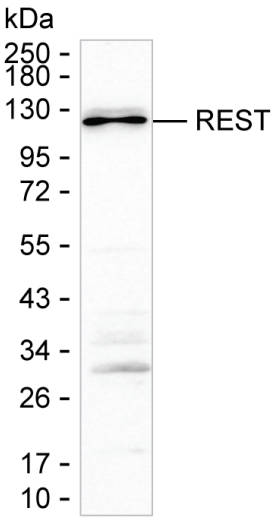
| WB | 咨询技术 | Human,Mouse,Rat |
| IF | 咨询技术 | Human,Mouse,Rat |
| IHC | 咨询技术 | Human,Mouse,Rat |
| ICC | 技术咨询 | Human,Mouse,Rat |
| FCM | 咨询技术 | Human,Mouse,Rat |
| Elisa | 咨询技术 | Human,Mouse,Rat |
| Host/Isotype | Mouse IgG2a |
| Antibody Type | Primary antibody |
| Storage | Store at 4°C short term. Aliquot and store at -20°C long term. Avoid freeze/thaw cycles. |
| Species Reactivity | Human |
| Immunogen | Purified recombinant fragment of human REST |
| Formulation | Purified antibody in PBS with 0.05% sodium azide |
+ +
以下是关于REST抗体的3-4篇参考文献及其简要内容:
---
1. **文献名称**:*REST: A mammalian silencer protein that restricts sodium channel gene expression to neurons*
**作者**:Chong, J.A., et al.
**摘要**:该研究首次鉴定了REST(RE1沉默转录因子),揭示了其作为抑制性转录因子的功能,通过结合神经元基因的RE1元件,抑制非神经元细胞中的靶基因表达。研究中可能涉及REST抗体的使用以定位蛋白。
---
2. **文献名称**:*Nerve growth factor-dependent regulation of REST in neuronal differentiation*
**作者**:Huang, Y., et al.
**摘要**:探讨REST在神经分化中的调控机制,证明神经生长因子通过下调REST表达促进神经元特异性基因激活。研究利用REST抗体进行免疫印迹和染色质免疫沉淀(ChIP)分析。
---
3. **文献名称**:*Regulation of neuronal traits by a transcriptional repressor: REST in development and disease*
**作者**:Ballas, N., et al.
**摘要**:综述REST在神经发育和疾病(如癌症、癫痫)中的作用,强调其实验中REST抗体在检测蛋白表达及DNA结合活性中的应用。
---
4. **文献名称**:*REST-mediated repression of neuronal genes in glioblastoma*
**作者**:Wagoner, M.P., et al.
**摘要**:研究发现胶质母细胞瘤中REST异常高表达,抑制神经元相关基因,促进肿瘤恶性表型。研究使用REST抗体进行免疫组化及功能验证实验。
---
以上文献涵盖REST的功能、机制及疾病关联,均涉及抗体的实验应用(如Western blot、ChIP等)。如需具体实验细节,可进一步查阅原文。
REST (RE1-Silencing Transcription factor), also known as NRSF (Neuron-Restrictive Silencer Factor), is a transcriptional repressor critical for regulating neuronal gene expression. Initially identified in 1995. REST binds to RE1 (Repressor Element 1) sequences in target genes, suppressing their transcription in non-neuronal cells and neural stem/progenitor cells. This ensures neuronal-specific genes remain inactive outside mature neurons, maintaining cellular identity. Dysregulation of REST is implicated in neurological disorders, cancers, and other diseases. For instance, aberrant REST activity contributes to neurodegeneration, epilepsy, and neurodevelopmental defects, while its overexpression in tumors like neuroblastoma or glioblastoma promotes oncogenesis.
REST antibodies are essential tools for studying its expression, localization, and molecular interactions. They enable techniques such as Western blotting, immunohistochemistry (IHC), and chromatin immunoprecipitation (ChIP) to map REST-DNA binding sites or assess its protein levels across tissues. Specific antibody validation is crucial due to REST’s multiple splice variants and post-translational modifications. Commercially available REST antibodies target epitopes in its N-terminal repressor domain or C-terminal zinc finger regions. Research using these antibodies has clarified REST’s role in neuronal differentiation, synaptic plasticity, and disease mechanisms, highlighting its dual function as a tumor suppressor or oncogene depending on cellular context. Ongoing studies continue to explore REST-targeted therapies and diagnostic applications.
×